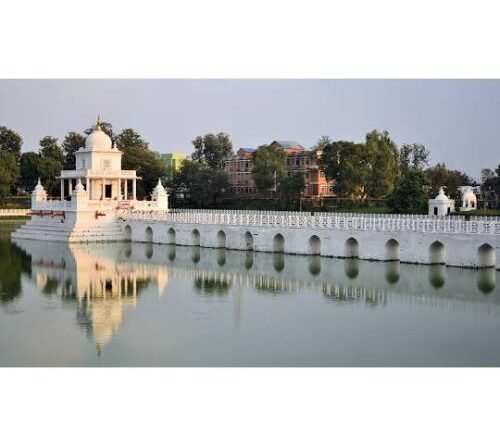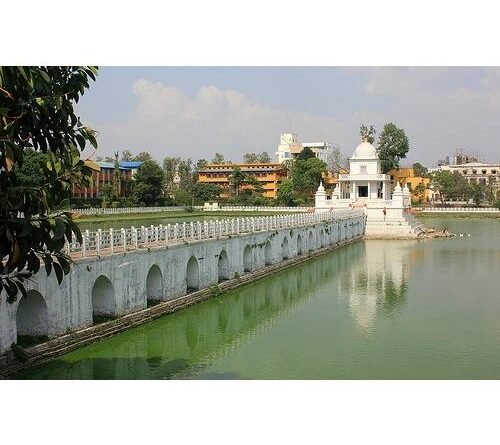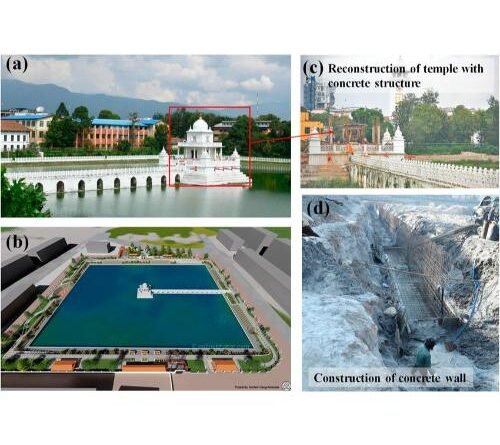Rani Pokhari Shiv Mandir/Rani Pokhari Nepal
Rani Pokhari, originally known as Nhu Pukhu lit. new pond), is a historic artificial pond located in the heart of Kathmandu, Nepal. The square-shaped tank dates from the 17th century, and was built on the eastern side of the then city limits. It lies just outside a former city gate. The pond is one of Kathmandu’s most famous landmarks and is known for its religious and aesthetic significance.
Rani Pokhari was built in 1670 AD by King Pratap Malla, one of the most illustrious monarchs of the Malla dynasty that ruled Nepal for more than 600 years. Pratap Malla had the tank constructed to console his queen who was distraught with grief after their son was trampled to death by an elephant. He had water collected from various holy places and river confluences in Nepal and India like Gosaikunda, Muktinath, Badrinath, Kedarnath and poured into the pond to sanctify it.
The pond is recharged by water flowing in through an underground channel, but there are also seven wells inside the pond.
King Pratap Malla installed a stone slab at Rani Pokhari with writings in three languages: Sanskrit, Nepali and Nepal Bhasa. It is dated Nepal Sambat 790 (1670 AD) and describes the construction of Rani Pokhari and its religious significance. It also mentions five Brahmins, five Pradhans (Chief-ministers) and five Khas Magars as being witnesses.
A temple dedicated to Matrikeshwor Mahadev, a form of the Hindu deity Shiva, stands at the center of the pond. There is an idol of Harishankari, which is said to be the only one idol of both Saraswoti and Laxmi. It is reached from the street by a causeway. A large stone statue of an elephant bearing the images of Pratap Malla and his two sons Chakravartendra Malla and Mahipatendra Malla is situated on the tank’s southern embankment.
There are four smaller temples situated at the four corners of the pond: Bhairava temples in the northwest and northeast, Mahalaxmi Temple in the southeast and Ganesh Temple in the southwest. The temples on the eastern side now lie within the compounds of Tri Chandra College and a police station which has undermined their cultural importance.
During the construction of the Ratnapark Subway, starting in 1984, Nhera hiti was discovered. Some of the stone spouts are now in the National Museum of Nepal. An unnamed dhunge dhara is known to be buried on the premises of the Nepal Electricity Authority (NEA). Then there is Swora hiti or Tin Dhara at Durbar Marg. The fourth dhunge dhara is named Jhanga hiti. It is located in Jamal, on the north-western corner of Rani Pokhari. Of these four dhunge dharas, only Swora hiti is in working order.
The temple at the centre of the lake is open to the public only once a year: during the Yamapanchak or Tihar, the Festival of Lights. Traditionally, it opens on the Day of “Bhaitika” when sisters bless brothers for longevity and good health.
Rani Pokhari is fenced with iron bars and opened once a year during Bhai Tika, the fifth and final day of the Tihar, and Chhath festival. The world’s largest Chhath festival takes place every year in Rani Pokhari. Rani is also dedicated to (Nepalese Maithil) Women who go into the cold water and pray to the Sun God.
















